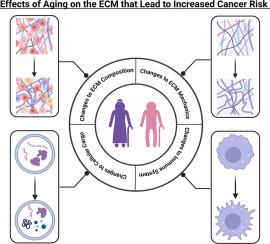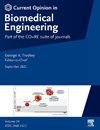衰老和细胞外基质:肿瘤容许微环境驱动癌症进展
IF 4.2
3区 工程技术
Q2 ENGINEERING, BIOMEDICAL
引用次数: 0
摘要
衰老是一个重要的癌症危险因素,但其对细胞外基质(ECM)在肿瘤发生和发展中的影响一直被忽视。虽然大量的研究集中在衰老和癌症之间的细胞和遗传联系上,但最近的研究强调了年龄诱导的ECM变化如何创造一个肿瘤允许的环境。在这里,我们回顾了这一新兴的研究领域,其中年龄相关的ECM改变,如年龄诱导的基质硬度增加、生化变化和由此产生的机械敏感途径失调,探讨了它们在癌症发生和发展中的影响。此外,最近的研究表明,衰老细胞如何促进ECM的改变,进一步加强肿瘤允许的变化。本文综述了ECM老化的两个方面,即材料驱动和细胞驱动,并强调了目前对ECM老化如何影响多种癌症类型肿瘤微环境内相互作用的理解,重点是生物力学方面。我们还讨论了促进年龄依赖性癌症进展和治疗反应研究的新兴年龄模拟体外模型。最后,我们回顾了针对衰老相关成分或ECM变化的治疗策略,以提高治疗效果。本文章由计算机程序翻译,如有差异,请以英文原文为准。

Aging and the extracellular matrix: A tumor-permissive microenvironment driving cancer progression
Aging is a significant cancer risk factor, yet its impact on the extracellular matrix (ECM) in tumor initiation and progression has been traditionally overlooked. While significant amounts of research focus on cellular and genetic links between aging and cancer, recent studies highlight how age-induced ECM changes create a tumor-permissive environment. Here we review this emerging research area, where age-related ECM alterations, such as age-induced increases in matrix stiffness, biochemical changes, and resultant dysregulated mechanosensitive pathways, are explored for their influence in cancer initiation and progression. Additionally, recent studies have showed how aged cells contribute to ECM alterations, further reinforcing tumor-permissive changes. This review examines both aspects of ECM aging, i.e. material-driven and cell-driven, and highlights current understandings of how ECM aging influences interactions within the tumor microenvironment in multiple cancer types, with a focus on biomechanical aspects. We also discuss emerging age-mimetic in vitro models facilitating studies of age-dependent cancer progression and therapeutic responses. Finally, we review therapeutic strategies that target aging-associated components or ECM changes to improve treatment efficacy.
求助全文
通过发布文献求助,成功后即可免费获取论文全文。
去求助
来源期刊

Current Opinion in Biomedical Engineering
Medicine-Medicine (miscellaneous)
CiteScore
8.60
自引率
2.60%
发文量
59
 求助内容:
求助内容: 应助结果提醒方式:
应助结果提醒方式:


